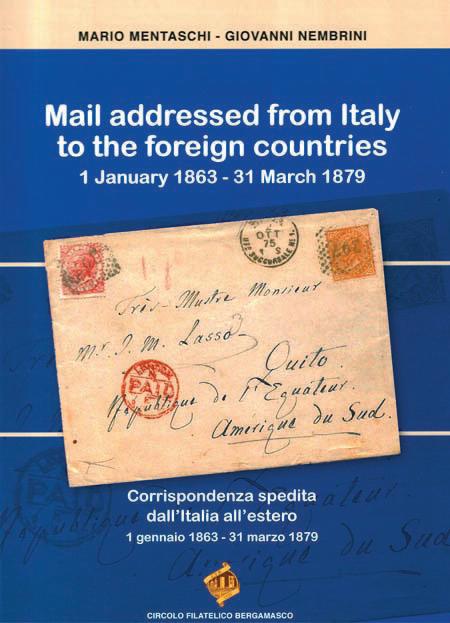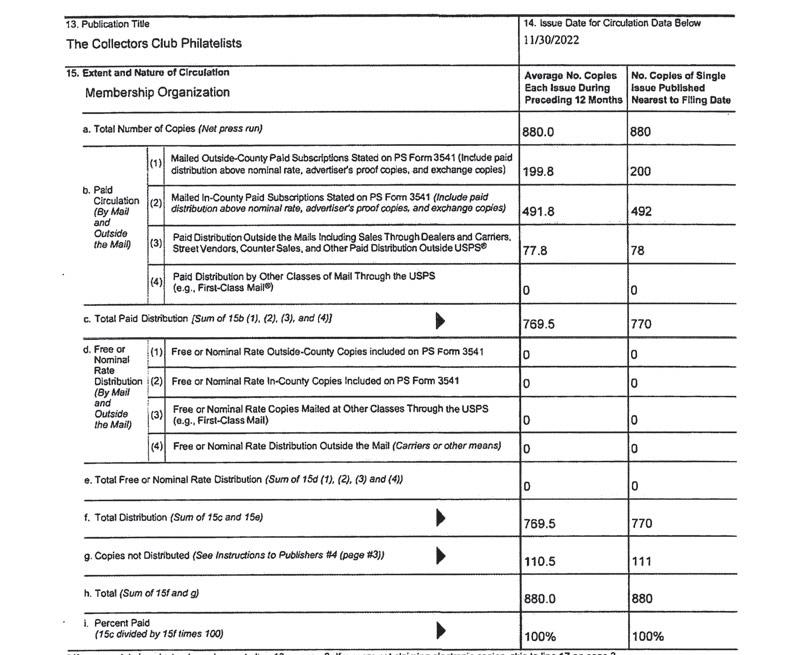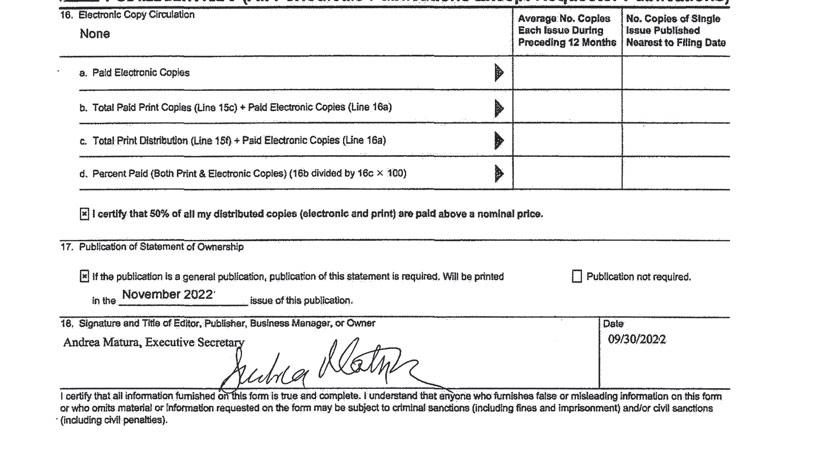
5 minute read
by Giorgio Migliavacca
The fi rst lett erpress sett ing for sheets of 15 stamps is plated in its variations. A similar hand overprint on 5d. Greek postal stationery is very rare. A chart on pages 146 and 147 wraps up this rare overprint in its uses.
New postal censorship offi ces were opened between September 1941 and September 1943 at Cefalonia, Itaca, Santa Maura and Zante.
Advertisement
Another chapter covers the plethora of regulations in their original text regarding censorship in colonies and territories; this section alone is very precious to the specialist.
The research is very impressive and detailed; the production is lavish, to say the least. Keep in mind that only 200 copies were printed and their availability will end rather soon.
– Giorgio Migliavacca
Mario Mentaschi and Giovanni Nembrini, Mail addressed from Italy to the foreign countries – 1 January 1863 – 31 March 1879 (Corrispondenza dall’Italia all’estero - 1 gennaio 1863-31 marzo 1879), hardbound, (8 by 11¾ inches), 212 pages, more than 266 color illustrations throughout, maps; in Italian and English, published by Circolo Filatelico Bergamasco, 2021; €40 plus postage, available from Vaccari (info@vaccari.it)
It is quite gratifying to see how philatelic and postal history literature is always on track with the latest research; it is also reassuring to see volumes made possible by the research of two or three scholars “combined.” This book is written by Mario Mentaschi, a well-known name in postal history for his books, which have garnered gold medals at various FIP international exhibitions; the co-author is Giovanni Nembrini, a keen collector of Italian postal history with emphasis on Italy 1850-1900. His collections have won grand prix and gold medals at national and international exhibitions while his articles have been published by Cursores and Vaccari Magazine.
The introduction outlines the main subject of this volume: the complexities of unifying Italy, not only politically but also postally. If there were obstacles and diffi culties in postal communications nationally, one can only imagine what was communicating internationally.
During the 17th and 18th centuries, the exchange of mail between countries was largely regulated by bilateral postal agreements. But by the 1800s, bilateral agreements had become so complex that they began to impede the rapidly developing trade and commercial sectors. Order and simplifi cation were needed by the international postal services.

Collectors Club Philatelist Volume 101, Number 6 379
On March 17, 1861, a Sunday, the Kingdom of Italy became a reality and the integration of various states was in itself a gigantic task. A valid remedy came on Jan. 1, 1863, when the May 5, 1862, law sett ing new rules was adopted and enforced nationwide. At that point, Italy was unifi ed postally. That turning point is also the starting moment of the postal history examined by this book, with special att ention given to international mail rules, procedures and tariff s that, until June 1875, were based on postal conventions with foreign postal administrations. If no convention was signed with a given country, the best practice was to seek the mediation of other countries, such as France and Great Britain.
Postal rates for international mail from July 1, 1875, to March 31, 1879, were regulated by a convention signed in Berne by General Postal Union (GPU) and 22 member countries, including Italy.
This expansion of an organized postal network connected small and large businesses alike to customers everywhere. More progress was made with the advent of the Universal Postal Union, whose convention was endorsed by 32 countries with eff ect from April 1, 1879. The Mentaschi-Nembrini monograph delves into the postal routes, as well as the chronological evolution of the tariff s within each country.
A lengthy and well-articulated chapter examines the mail sent to other Italian states during the years leading to the unifi cation and after, with special att ention to Austrian Venetia, the Papal States and the Republic of San Marino.
The next chapter focuses on mail from Italy to various foreign countries conveyed using various modalities depending on the location of the fi nal destination. On the old continent, foreign countries were reachable using overland routes; for more distant destinations, such as Africa and Asia, the sea routes were served by French and British packets and the Austrian Lloyd, which also connected with African countries facing the Mediterranean. Postal communications with the northern New World were served by British and American packets.
Central America and the West Indies were served by British and French packets: postal communications with South America facing the Atlantic were facilitated by French packets; countries facing the Pacifi c were served by British packets of the Pacifi c Steam Navigation Co. Destinations beyond the Suez Canal were served by the P & O Steam Navigation Co. and by French packets.
In most cases, covers from the Nembrini collection exemplify tariff s and routes and means of conveyance; in other instances, illustrations from other important collections were utilized to give the reader practical examples of what is being discussed.
Mail to European countries and territories is examined in great detail; the countries involved are Austrian Empire, Belgium, Denmark, Finland, France, Gibraltar, German States, Luxembourg, Norway, Russian Empire, Romania,
380 November-December 2022 www.collectorsclub.org
Serbia, Spain, Sweden, Switz erland, the Netherlands and United Kingdom. The next chapter illustrates the tariff s from Italy to countries facing the Mediterranean basin including Asian countries, Ott oman Empire, Greece, Algeria, Egypt and Tunisia. Next are countries and colonies of the Atlantic coast, including the Canary Islands, Cape of Good Hope, Gold Coast and Sierra Leone.
Countries and British Colonies of North America are next: Canada, Nova Scotia and the United States. Following are Central American countries and colonies: Bahamas, Cuba, Dominican Republic, Guatemala, Jamaica, Mexico, Puerto Rico, St. Thomas (Danish Antilles), Trinidad and Venezuela. To complete South America, the countries examined are Argentina, Brazil, Chile, Ecuador, Peru and Uruguay.
The world beyond Suez included Asian and Australian countries served by French packets and later by P&O: Aden, Ceylon, China, India, Japan, New South Wales, New Zealand, Singapore and Victoria.
To conclude, this most useful volume comes with an exhaustive table of postal rates, followed by indices of currencies, contract packets, postal conventions, postal markings, as well as a comprehensive bibliography.
Given the vast postal delivery horizon visited by this book, its cost can be considered a bargain, especially if you spot the right cover at a dealers’ bourse or in an auction. Additionally, a lot of new information can prove very useful for covers you already have in your collection. In short, this book will pay for itself – undoubtedly a “must have.”
– Giorgio Migliavacca



Collectors Club Philatelist Volume 101, Number 6 381










